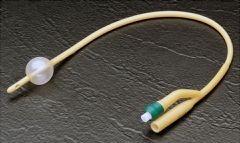
Foley catheters are flexible (usually latex) tubes that are passed through the urethra, during urinary catheterization, and into the bladder to drain urine. They are retained by means of a balloon at the tip which is inflated with sterile water. The balloons typically come in two different sizes: 5 cc and 30 cc.
The relative size of a Foley catheter is described using French units (F). The most common Foley catheters typically range from 10 F - 28 F. 1 F is equivalent to 0.33 mm = .013" = 1/77" of diameter. Thus the size in French units is roughly equal to the circumference of the catheter in millimeters.
They were designed by Dr. Frederick Foley, a surgeon working in Boston, Massachusetts in the 1930s, back when he was a medical student.
His original design was adopted by C. R. Bard of Murray Hill, New Jersey, who manufactured the first prototypes and named them in honor of the surgeon.
Types of Foley Catheter
Foley catheters come in several sub-types. Coudé (French for elbowed) catheters have a 45° bend at the tip to allow easier passage through an enlarged prostate. Council tip catheters have a small hole at the tip which allows them to be passed over a wire. 3-way catheters are used primarily after bladder, prostate cancer or prostate surgery. They have a third arm or bell that allows an irrigant to pass to the tip of the catheter through a small separate channel into the bladder. This serves to wash away blood and small clots through the primary arm that drains into a collection device. This prevents larger clots, which might plug the catheter, from forming. The second (or inflation) arm has a small plastic valve that allows for the introduction or removal of sterile water through a very small channel to inflate or deflate the retaining balloon.
Uses
Foley catheters are used during the following situations:
- On patients who are anesthetized or sedated for surgery or other medical care
- On comatose patients
- On some incontinent patients
- On patients whose prostate is enlarged to the point that urine flow from the bladder is cut off. The catheter is kept in until the problem is resolved.
- On patients with acute urinary retention.
- On patients who are unable to use either standard toilet facilities or urinals due to paralysis or physical injury.
- Following urethral surgeries
- Sometimes before Furosemide administration
Disadvantages
A major problem with Foley catheters is that they have a tendency to contribute to urinary tract infections (UTI). This occurs because bacteria can travel up the catheters to the bladder where the urine can become infected. To combat this, the industry is moving to antibiotic coated catheters. This has been helpful, but it has not completely solved this major problem. An additional problem is that Foley catheters tend to become coated over time with a biofilm that can keep them from properly draining the bladder. This increases the degree of static urine left in the bladder, which further contributes to the problem of urinary tract infections. When a Foley catheter becomes clogged, it must be flushed or replaced. Thus keeping Foley Catheters from clogging may help reduce UTIs as well.
